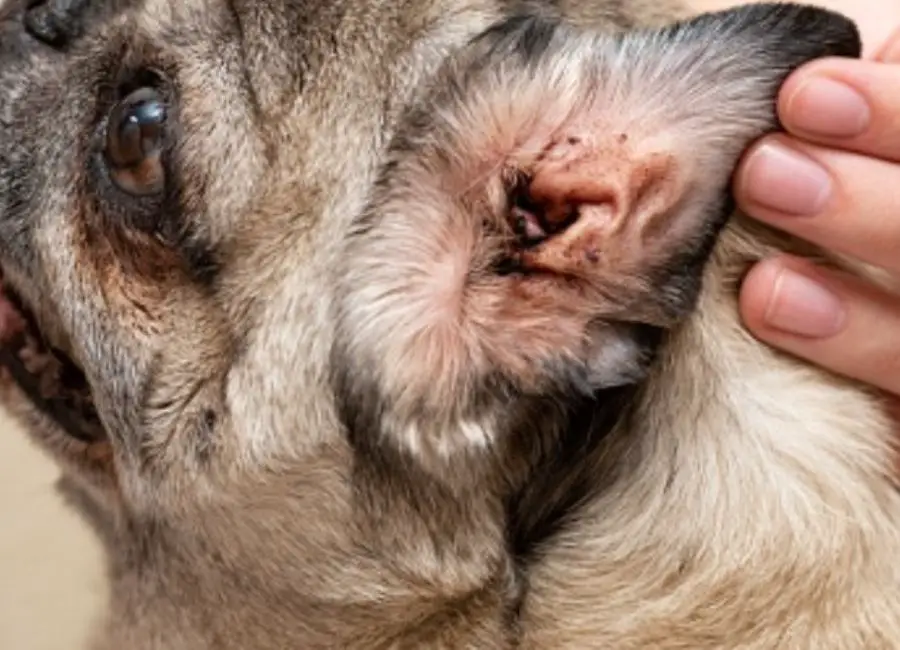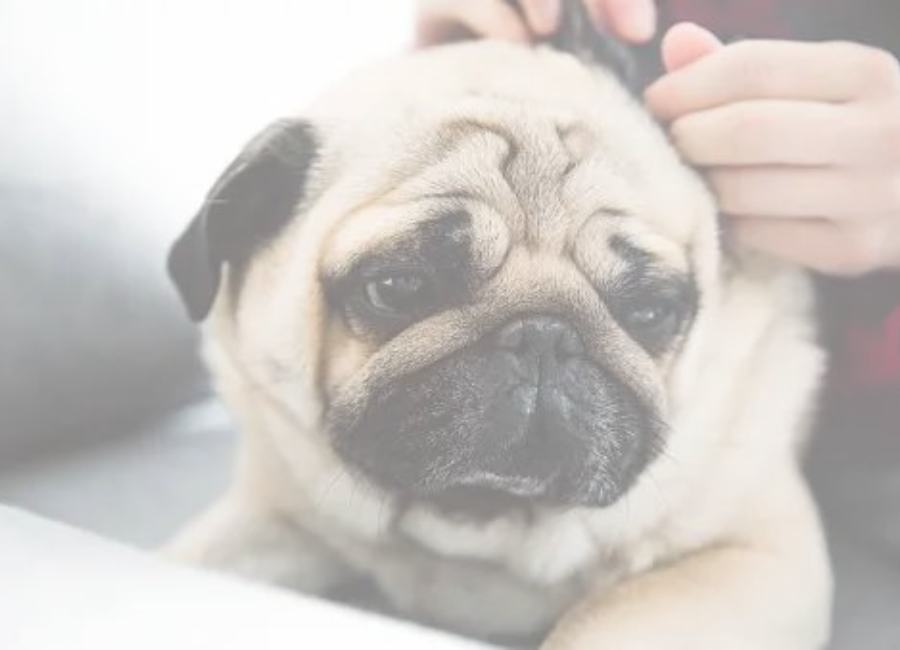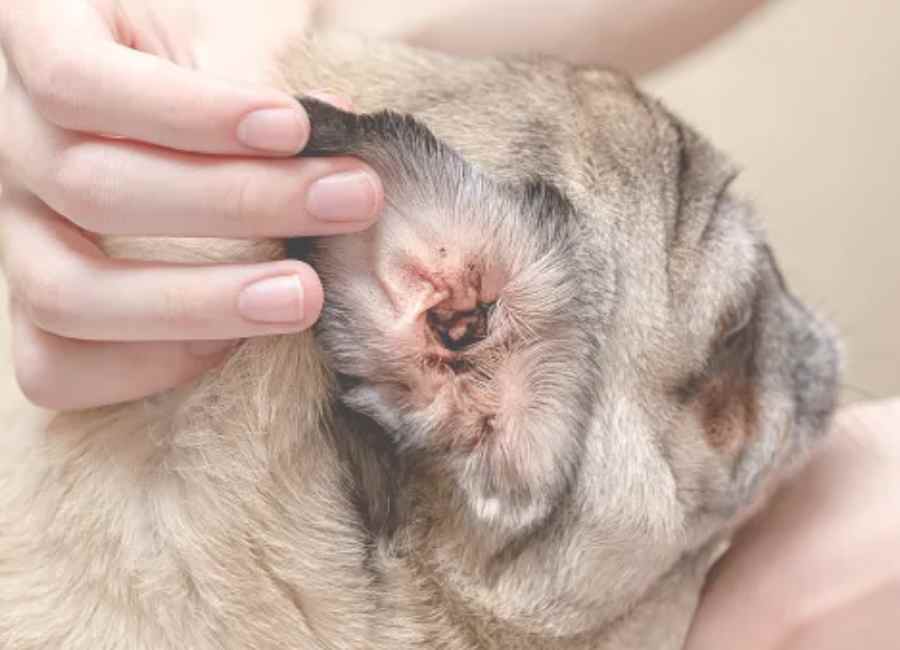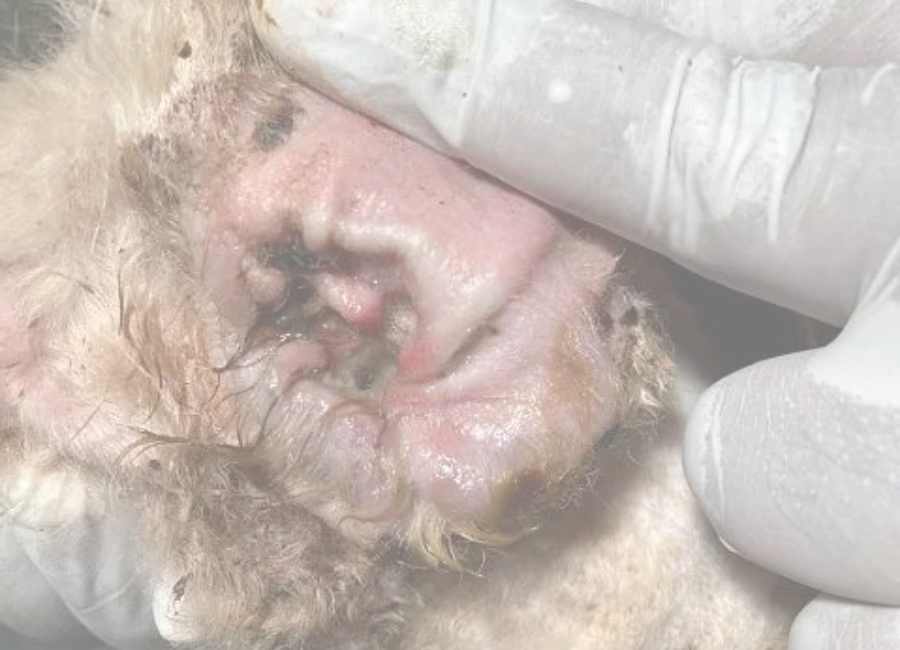Insight to Pug Ear Cleaning & Ear Problems

Let’s discuss pug ear cleaning tips and ear problems…
We know that taking care of your furry best friend entails a lot of work, and one essential task that should never be overlooked is cleaning their ears. Pugs, in particular, have some unique ear characteristics that require extra attention and care.
In this post, we’ll share some valuable tips on how to properly clean your pug’s ears, including some dos and don’ts to keep in mind. So, grab a cup of coffee, sit back, and get ready to learn how to give your pug’s ears the TLC they deserve!
Why is ear cleaning important for pugs?
Due to their distinct ear structure and propensity for moisture buildup, pugs, like many other dog breeds, are susceptible to specific ear issues.
Regular ear cleaning helps avoid the buildup of debris, excess moisture, wax, and other substances that can cause infections and discomfort.
By keeping your pug’s ears clean, you can lower the possibility of ear infections, inflammation, and other related problems that could cause them unneeded pain.
The Anatomy of a Pug’s Ear
To effectively clean your pug’s ears, it’s important to understand their ear anatomy. Pugs have small, folded ears that can trap moisture and debris easily.
Additionally, their ear canals are L-shaped, making it difficult for proper airflow and drainage. These factors contribute to an increased risk of ear problems, emphasizing the need for regular cleaning.
Pug Ear Cleaning

Here’s the step-by-step guide to cleaning your pug’s ears:
Gather the necessary supplies: Prepare a soft towel, cotton balls or pads, and an appropriate pug ear cleaning solution recommended by your veterinarian.
Create a calm and comfortable environment: Choose a quiet space where your pug feels relaxed and secure. This will help make the pug ear cleaning process more comfortable for both of you.
Examine the ears for any visible issues: Before cleaning, check for any signs of redness, swelling, discharge, or other abnormalities in your pug’s ears. If you notice anything unusual, consult your veterinarian before proceeding.
Choose an appropriate ear cleaning solution: Use a veterinarian-recommended ear cleaning solution specifically formulated for dogs. Avoid using alcohol, hydrogen peroxide, or any other harsh substances, as they can irritate the delicate ear tissues.
Apply the cleaning solution: Gently lift your pug’s ear flap and carefully fill the ear canal with the cleaning solution. Be cautious not to insert the nozzle too deeply, as it can cause discomfort.
Gently massage the base of the ear: After applying the cleaning solution, gently massage the base of your pug’s ear for approximately 30 seconds. This helps distribute the solution and loosen any debris or wax buildup.
Use a cotton ball or pad to remove debris: Take a cotton ball or pad and gently wipe away any dirt, wax, or debris that comes to the surface. Avoid using cotton swabs, as they can push debris further into the ear canal or cause damage.
Avoid using cotton swabs: It’s essential to refrain from using cotton swabs in your pug’s ears. The ear canal is delicate, and inserting cotton swabs can lead to injuries or push debris deeper, exacerbating the problem.
Reward your pug with treats and praise: After the cleaning process, reward your pug with treats and praise to create positive associations with ear cleaning. This will make future cleaning sessions more enjoyable for your furry friend.
Learn more about pug grooming.
How often should you clean your pug’s ears?
The frequency of ear cleaning depends on your pug’s individual needs and susceptibility to ear problems. As a general guideline, cleaning your pug’s ears once a month is usually sufficient for most pugs.
However, if your pug is prone to ear infections or excessive wax buildup, your veterinarian might recommend more frequent cleanings.
Pug ear problems

Here are some common Pug ear problems:
1. Ear Infections: Ear infections are a common issue in many dog breeds, and Pugs are no exception. Their folded ears create a warm and moist environment that is perfect for bacteria to grow and cause infections. Signs of ear infection in Pugs include foul smell, discharge, excessive scratching, and redness.
2. Allergies: Pugs are also prone to allergies, which can cause inflammation in their ears. This can lead to itchiness, swelling, and redness in the ear, making it uncomfortable for the dog. Allergic reactions can be caused by certain foods, environmental factors, or other irritants.
3. Ear Mites: Ear mites are tiny parasites that can cause ear infections and other ear problems in Pugs. These parasites live in the ear canal and feed on the wax and oils in the ear. Ear mites can cause itching, inflammation, and discharge in the ear, and can be very uncomfortable for the dog.
4. Hematomas: Hematomas are collections of blood that can occur in the ear flap due to head shaking or ear scratching. Pugs are prone to hematomas because of their floppy ears, which can trap moisture and debris. Hematomas can be painful and require medical attention.
5. Foreign Objects: Pugs are curious dogs, and they can sometimes get foreign objects stuck in their ears. These objects can cause pain, swelling, and infection in the ear, and can be difficult to remove without professional help.
6. Yeast Infections: Yeast infection is another common problem in Pug ears. It is caused by excessive moisture in the ears, which creates an ideal environment for yeast to grow. Signs of yeast infection in Pug ears include itching, redness, and a strong smell.
It is important for Pug owners to monitor their dogs’ ears and visit the veterinarian regularly to prevent and treat any ear problems. Cleaning and maintaining the ears can also help prevent many ear problems in Pugs.
Signs of Ear Problems in Pugs
It’s crucial to be aware of signs that indicate potential ear problems in your pug. Some common signs include:
- Frequent scratching or rubbing of the ears
- Redness, swelling, or discharge from the ears
- Unpleasant odor coming from the ears
- Increased sensitivity or pain when the ears are touched
- Head shaking or tilting to one side
- Loss of balance or coordination
If you notice any of these signs, it’s advisable to consult a veterinarian for a proper diagnosis and treatment.
Tips for Preventing Ear Problems in Pugs
Here are some common tips for preventing ear problems in Pugs:
1. Regular Ear Cleaning
Cleaning your Pug’s ears regularly can help prevent ear problems. Use a gentle solution and a soft cloth or cotton ball.
2. Avoid Over-Cleaning
Over-cleaning your Pug’s ears can lead to irritation and make them more susceptible to infections.
3. Proper Grooming
Keeping your Pug’s fur clean and trimmed around the ears can help prevent ear infections.
4. Avoid Moisture
Pugs are prone to ear infections due to their short, wide ear canals. Avoid letting moisture get trapped in their ears by drying them after they swim or get wet.
5. Monitor for Allergies
Pugs are prone to skin allergies, which can also affect their ears. Monitor for signs of allergies and seek treatment if necessary.
6. Avoid Hot and Humid Environments
Pugs are sensitive to heat and humidity, which can make them more susceptible to ear infections. Keep them in a cool, dry environment.
7. Regular Vet Check-Ups
Regular visits to the vet can help catch and treat ear problems early on. Your vet can also provide guidance on how to prevent ear problems in your Pug.
Diagnosing Ear Problems in Pugs
Ear infections can be a common health concern in pugs. Here are some factors that can help with the diagnosis:
- Visual Assessment: A veterinarian may perform a visual assessment of the dog’s ears for signs such as redness, swelling, and discharge.
- Otoscopic Examination: An otoscope is a tool that enables a veterinarian to examine the ear canal and eardrum. An otoscopic examination may help identify foreign bodies, wax plugs, or parasites, which could be causing discomfort to the dog.
- Microscopic Examination: This test may help to identify the type of bacteria or microorganism causing the ear infection.
- Serum Test or Intradermal Skin Test: To diagnose environmental allergies, a veterinarian may recommend a serum test or an intradermal skin test.
- CT Scan: In some cases, a CT scan may be needed to diagnose the problem. A study found that pugs and French bulldogs with brachycephalic airway syndrome have been shown to have extreme narrowing of the external auditory canal and problems with the eardrum.
Once a diagnosis is made, the veterinarian will recommend an appropriate course of treatment, which may include prescription medications, cleaning of the ears, and in some cases, surgery.
Treatment Options for Ear Problems in Pugs

Here are some of the treatment options for ear problems in Pugs:
1. Medications:
The treatment of ear infections in dogs involves the use of medications such as antibiotics, antifungals, and anti-inflammatory drugs depending on the severity and cause of the infection. In the case of fungal infections, an antifungal medication like itraconazole may be prescribed by the vet.
2. Medicated ear cleaners:
Vets may also use a medicated ear cleaner to clean the ears and provide relief to the pug. Such cleaners may contain ingredients like antibiotics, antifungals, or anti-inflammatory agents.
3. Surgery (in severe cases):
In severe cases where ear infections are chronic or when other treatments have failed, surgery may be an option. However, surgery for ear infections is not a widely available option, according to one of the search results.
It’s important to note that treatment of ear infections in Pugs should always be done under the guidance of a veterinarian, who can diagnose and determine the cause of the condition and prescribe the appropriate treatment.
Misconceptions about pug ear cleaning
There are a few misconceptions surrounding pug ear cleaning that are important to address:
Myth: Cleaning the ears too often is harmful.
Fact: Cleaning your pug’s ears too frequently can disrupt the natural balance of the ear canal. However, regular monthly cleaning, or as recommended by your veterinarian, is beneficial and safe.
Myth: Homemade solutions are as effective as commercial ones.
Fact: Homemade solutions, such as vinegar and water mixtures, may not be as effective in removing debris or addressing specific ear issues. It’s best to use veterinarian-recommended solutions for optimal results.
Myth: Pugs don’t need regular ear cleaning.
Fact: Pugs are more prone to ear problems due to their unique ear structure. Regular ear cleaning is essential to prevent infections and maintain their overall ear health.
Related Questions
Can I use homemade solutions for pug ear cleaning?
While there are homemade solutions available, it’s best to use veterinarian-recommended ear cleaning solutions for optimal results and safety.
What should I do if my pug’s ears smell bad?
If your pug’s ears have a foul odor, it could indicate an infection or other underlying issues. It’s advisable to consult your veterinarian for proper diagnosis and treatment.
Are pugs more prone to ear infections?
Yes, pugs are more susceptible to ear infections due to their unique ear structure. Regular cleaning and preventive measures can help minimize the risk.
Can I clean my pug’s ears too often?
Cleaning your pug’s ears too frequently can disrupt the natural balance of the ear canal. Follow the recommended frequency of monthly cleanings, or as advised by your veterinarian.
Should I seek veterinary assistance for ear cleaning?
If you are unsure about how to clean your pug’s ears or notice any signs of ear problems, it’s best to consult your veterinarian for professional guidance and assistance.
Learn more about senior pug care and problems.
Conclusion
Proper ear cleaning is an essential part of caring for your pug. By maintaining clean ears, you can prevent ear infections, discomfort, and potential complications.
Follow the step-by-step guide provided in this article, and remember to consult your veterinarian if you notice any signs of ear problems.
By dedicating a little time and attention to your pug’s ear hygiene, you can ensure their well-being and keep those adorable ears healthy and happy.
